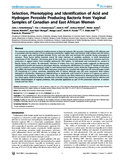| dc.contributor.author | Schellenberg, John J. | |
| dc.contributor.author | . Dumonceaux, Tim J | |
| dc.contributor.author | Hill, Janet E. | |
| dc.contributor.author | Kimani, Joshua | |
| dc.contributor.author | Jaoko Walter G. | |
| dc.contributor.author | Wachihi, Charles | |
| dc.contributor.author | Mungai, Jane Njeri | |
| dc.contributor.author | Lane, Margo | |
| dc.contributor.author | Fowke, Keith R. | |
| dc.contributor.author | Ball, T. Blake | |
| dc.date.accessioned | 2013-02-19T05:13:59Z | |
| dc.date.issued | 2012 | |
| dc.identifier.uri | http://www.ncbi.nlm.nih.gov/pubmed/22844440 | |
| dc.identifier.uri | http://www.ncbi.nlm.nih.gov/pmc/articles/PMC3402533/ | |
| dc.identifier.uri | http://erepository.uonbi.ac.ke:8080/xmlui/handle/123456789/10140 | |
| dc.description.abstract | The common but poorly understood condition known as bacterial vaginosis (BV) increases vulnerability to HIV infection and is associated with the absence of H(2)O(2)-producing Lactobacillus. Vaginal lactic acid bacteria (LAB) produce anti-HIV factors such as organic acids and hydrogen peroxide (H(2)O(2)), and may bind and inactivate HIV particles during scavenging of mannose. These factors define potential criteria for initial selection of candidate probiotics to block heterosexual transmission of HIV. Therefore, the primary goal of this study was to characterize acid production on mannose and H(2)O(2) production in vaginal isolates from Canadian adolescents (192 isolates, 16 individuals) and commercial sex workers in Nairobi, Kenya (576 isolates, 96 individuals). Selection of isolates from H(2)O(2)-detecting media suggested an idiosyncratic individual-level profile and extensive phenotypic diversity, including the identification of a subset of "double-strong" acid- and H(2)O(2)-producers with phenotypes similar to well-characterized probiotic strains. Molecular fingerprinting of all isolates by capillary electrophoresis of 16S-23S rRNA interspacer amplicons was coupled with chaperonin-60 universal target (cpn60 UT) sequencing in a subset, tentatively identifying 96% of isolates although only 19% were sequenced. Most isolates belonged to Lactobacillus, Streptococcus, Bifidobacterium or Gardnerella, with a total of 37 species in 15 genera, as well as 5 potentially novel organisms, identified in this study. This sensitivity was likely enhanced by phenotype-based selection on two chromogenic media formulations. Identification of double-strong isolates may provide a rational basis for selection and further characterization of vaginal probiotics, with potential application as part of HIV prevention initiatives in western Canada and East Africa. | |
| dc.description.sponsorship | The common but poorly understood condition known as bacterial vaginosis (BV) increases vulnerability to HIV infection and
is associated with the absence of H2O2-producing Lactobacillus. Vaginal lactic acid bacteria (LAB) produce anti-HIV factors
such as organic acids and hydrogen peroxide (H2O2), and may bind and inactivate HIV particles during scavenging of
mannose. These factors define potential criteria for initial selection of candidate probiotics to block heterosexual
transmission of HIV. Therefore, the primary goal of this study was to characterize acid production on mannose and H2O2
production in vaginal isolates from Canadian adolescents (192 isolates, 16 individuals) and commercial sex workers in
Nairobi, Kenya (576 isolates, 96 individuals). Selection of isolates from H2O2-detecting media suggested an idiosyncratic
individual-level profile and extensive phenotypic diversity, including the identification of a subset of ‘‘double-strong’’ acidand
H2O2-producers with phenotypes similar to well-characterized probiotic strains. Molecular fingerprinting of all isolates
by capillary electrophoresis of 16S-23S rRNA interspacer amplicons was coupled with chaperonin-60 universal target (cpn60
UT) sequencing in a subset, tentatively identifying 96% of isolates although only 19% were sequenced. Most isolates
belonged to Lactobacillus, Streptococcus, Bifidobacterium or Gardnerella, with a total of 37 species in 15 genera, as well as 5
potentially novel organisms, identified in this study. This sensitivity was likely enhanced by phenotype-based selection on
two chromogenic media formulations. Identification of double-strong isolates may provide a rational basis for selection and
further characterization of vaginal probiotics, with potential application as part of HIV prevention initiatives in western
Canada and East Africa. | en |
| dc.language.iso | en | en |
| dc.title | Selection, Phenotyping and Identification of Acid and Hydrogen Peroxide Producing Bacteria from Vaginal Samples of Canadian and East African Women | en |
| dc.type | Article | en |


